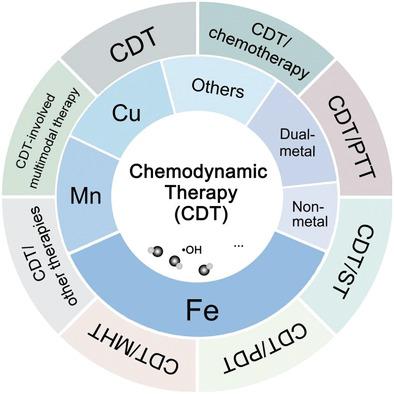Our official English website, www.x-mol.net, welcomes your
feedback! (Note: you will need to create a separate account there.)
Chemodynamic Therapy via Fenton and Fenton-Like Nanomaterials: Strategies and Recent Advances
Small ( IF 13.0 ) Pub Date : 2021-11-02 , DOI: 10.1002/smll.202103868 Chenyang Jia 1 , Yuxin Guo 1 , Fu-Gen Wu 1
Small ( IF 13.0 ) Pub Date : 2021-11-02 , DOI: 10.1002/smll.202103868 Chenyang Jia 1 , Yuxin Guo 1 , Fu-Gen Wu 1
Affiliation

|
Chemodynamic therapy (CDT), a novel cancer therapeutic strategy defined as the treatment using Fenton or Fenton-like reaction to produce •OH in the tumor region, was first proposed by Bu, Shi, and co-workers in 2016. Recently, with the rapid development of Fenton and Fenton-like nanomaterials, CDT has attracted tremendous attention because of its unique advantages: 1) It is tumor-selective with low side effects; 2) the CDT process does not depend on external field stimulation; 3) it can modulate the hypoxic and immunosuppressive tumor microenvironment; 4) the treatment cost of CDT is low. In addition to the Fe-involved CDT strategies, the Fenton-like reaction-mediated CDT strategies have also been proposed, which are based on many other metal elements including copper, manganese, cobalt, titanium, vanadium, palladium, silver, molybdenum, ruthenium, tungsten, cerium, and zinc. Moreover, CDT has been combined with other therapies like chemotherapy, radiotherapy, phototherapy, sonodynamic therapy, and immunotherapy for achieving enhanced anticancer effects. Besides, there have also been studies that extend the application of CDT to the antibacterial field. This review introduces the latest advancements in the nanomaterials-involved CDT from 2018 to the present and proposes the current limitations as well as future research directions in the related field.
中文翻译:

通过芬顿和类芬顿纳米材料进行化学动力学治疗:策略和最新进展
化学动力学疗法(CDT)是一种新的癌症治疗策略,定义为使用芬顿或类芬顿反应在肿瘤区域产生•OH的治疗,由布施等于2016年首次提出。随着芬顿和类芬顿纳米材料的快速发展,CDT因其独特的优势引起了极大的关注:1)具有肿瘤选择性,副作用低;2)CDT过程不依赖外场刺激;3)可调节缺氧和免疫抑制的肿瘤微环境;4)CDT的处理成本低。除了涉及 Fe 的 CDT 策略外,还提出了类 Fenton 反应介导的 CDT 策略,其基于许多其他金属元素,包括铜、锰、钴、钛、钒、钯、银、钼、钌, 钨、铈和锌。此外,CDT 已与其他疗法相结合,如化学疗法、放射疗法、光疗法、声动力疗法和免疫疗法,以实现增强的抗癌作用。此外,也有研究将CDT的应用扩展到抗菌领域。本综述介绍了 2018 年至今纳米材料参与 CDT 的最新进展,并提出了当前的局限性以及相关领域未来的研究方向。
更新日期:2021-11-02
中文翻译:

通过芬顿和类芬顿纳米材料进行化学动力学治疗:策略和最新进展
化学动力学疗法(CDT)是一种新的癌症治疗策略,定义为使用芬顿或类芬顿反应在肿瘤区域产生•OH的治疗,由布施等于2016年首次提出。随着芬顿和类芬顿纳米材料的快速发展,CDT因其独特的优势引起了极大的关注:1)具有肿瘤选择性,副作用低;2)CDT过程不依赖外场刺激;3)可调节缺氧和免疫抑制的肿瘤微环境;4)CDT的处理成本低。除了涉及 Fe 的 CDT 策略外,还提出了类 Fenton 反应介导的 CDT 策略,其基于许多其他金属元素,包括铜、锰、钴、钛、钒、钯、银、钼、钌, 钨、铈和锌。此外,CDT 已与其他疗法相结合,如化学疗法、放射疗法、光疗法、声动力疗法和免疫疗法,以实现增强的抗癌作用。此外,也有研究将CDT的应用扩展到抗菌领域。本综述介绍了 2018 年至今纳米材料参与 CDT 的最新进展,并提出了当前的局限性以及相关领域未来的研究方向。































 京公网安备 11010802027423号
京公网安备 11010802027423号